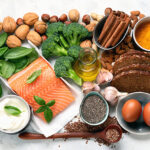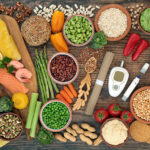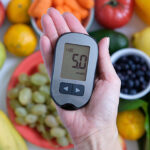Feedback—Your FAQs Answered
Is there any way I can change a bad carb like potatoes into a good carb? Or mellow a bad carb’s effects?
We tend not to talk good carbs bad carbs. We think it is more a question of balance. While you’ll benefit from eating healthy low GI carbs at each meal or for snacks, this doesn’t have to be at the exclusion of all others. High GI, carb-rich foods such as potatoes, wholemeal bread and brown rice make a valuable nutritional contribution to your diet. And when you combine them in a meal with low GI carbs such as lentils or beans or protein foods such as a piece of steak or fillet of fish, the overall GI value of the meal will probably be medium. See our tips for reducing the GI of your diet in Food for Thought this month. And if you love potatoes as so many people do, start by cutting back on the quantity. Either have one or two tiny chat potatoes with a small cob of corn, or make a cannellini bean and potato mash replacing half the potato with cannellini beans, or enjoy a small portion of potato salad with a vinaigrette dressing.
![[POTATO]](https://glycemicindex.com/blog/november2006/potatoes250b.jpg)
Should I use the GI or GL when planning meals?
We are often asked this. We recommend you use the GI, rather than GL, to identify your best carbohydrate choices. Emphasis on GL (ie GI x the amount of carbohydrate in the food) could easily lead to an unhealthy diet based on too few carbs. Some health professionals have unwittingly recommended the use of GL in place of GI on the basis that GL gives the best impression of a food’s overall effect on blood glucose levels. A few foods, for example, have a high GI but a normal serving of the food has a low GL (eg watermelon). That might well be true but it’s not a good reason to concentrate exclusively on the GL. Here’s why.
Carbohydrates with a low GI have a lot more going for them than simply keeping blood glucose levels on an even keel. Slow carbs, as we call them, are digested and absorbed slowly throughout the length of the small intestine. This makes them more likely to be filling and to stimulate the brain-gut peptides that spell ‘satiety’. Low GI carbs are also far more likely to be healthy foods such as legumes, fruits and dairy products that make a positive contribution to health in many ways (not just lowering blood glucose levels).
![[APPLES]](https://glycemicindex.com/blog/november2006/apples250.jpg)
If you concentrate on foods/meals with a low GL, you could well end up eating a diet that is too low in carbs and too high in saturated fat. Fatty meats like salami and bacon and cheese after all have a low GL. Although the GL concept is useful in scientific research, it’s the GI that’s proven to be most helpful to people day-to-day, say our dietitians. If you choose healthy low GI foods – at least one at each meal – chances are you’re eating a diet that not only keeps blood glucose within the healthy range, but contains balanced amounts of carbohydrates, fats and proteins.
I recently became a diabetic and was given a very brief course in nutrition to help me manage my glucose levels – without much success. Which of your books would help me?
Many people with diabetes struggle to keep their blood glucose on an even keel and lose weight – and not just when they are first diagnosed. It’s ongoing. That’s why it’s really important to see a registered dietitian who specialises in helping people with diabetes. It can really make a real difference long term. Your family doctor should be able to recommend one. As for books, we usually suggest Low GI Eating Made Easy for starters. It’s very practical and an easy read. It covers making the change to low GI eating in easy steps and lists the top 100 low GI foods and ways to include them in your diet. There’s also a week of low GI eating – breakfast, lunch, dinner and dessert ideas and the GI tables. If you want a bit more of the science behind the GI, check out The New Glucose Revolution Low GI Guide to Diabetes. You can get these books from Amazon and major booksellers.
Can I estimate a food’s GI by looking at the ingredient listing or nutrition label?
We are often asked this question. And the simple answer is that you can’t ‘work it out’. A packaged food’s Nutrition Facts panel will tell you the carbohydrate content, but it won’t indicate the GI of that food. If it contains at least 10 grams of carbohydrates per serving, you can be sure it will have at least some effect on your blood glucose concentration – but there’s no way of telling whether it will be a little or a lot. Similarly, you can’t estimate the GI of a food by looking at its ingredient list, because it won’t tell you the final state of the starches in the food – which ultimately determine GI value.
![[NUTRITION]](https://glycemicindex.com/blog/november2006/nutr.panel200.jpg)
However, you can make some generalisations about the GI of different foods that you can keep in mind when shopping. Legumes, for example, have some of the lowest GI values whether you buy them dried or canned, it doesn’t matter about the brand. Most pasta and noodle products tend to be low GI foods too as are most fresh fruits and dairy foods like milk, yogurt, ice cream, and custards. In contrast, most bread, bakery products, rice and breakfast cereals are high GI, although those that are less processed may be lower GI. Protein-rich foods—cheese, meat, eggs, and poultry – don’t have measurable GI values, because they contain little if any carbohydrates. The same is true for salad vegetables. Check out the database at www.glycemicindex.com for the most comprehensive list of GI values available. If you want something portable, you might like to pick up The New Glucose Revolution Shopper’s Guide to GI Values. It is updated each year, so look for the 2007 edition which should be published around November/December. And hound the manufacturers of your favourite foods to have them glycemic index tested ‘in vivo’ (that means what happens in real people not in a glass test tube) following the standard international procedure.
Have you done a GI study on winter squashes (pumpkins) such as hubbard, acorn, butternut etc?
There’s only been one published result for winter squash (it is listed as pumpkin) and it had a high GI (75). The actual variety tested isn’t given. But a typical serving of say 80 grams cooked winter squash is only going to have around 5–6 grams of carbohydrate, so the glycemic load will be quite low. That’s why we classify these healthy vegetables like winter squash and swedes etc. as ‘everyday caution with portion foods’ as we want people to eat plenty of vegetables (at least five servings a day) on a low GI diet. It’s only the starchy, carb-rich potato with a high GI that we suggest people cut back on.
![[PUMPKIN]](https://glycemicindex.com/blog/november2006/squash250.jpg)







